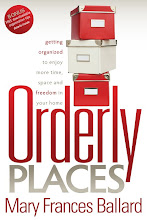Photo from Ikea
Organizing our clothing is a very significant part
of our life and it is a continual process. It takes money, time and
space. Pictures of many closet systems look organized mostly because there are so few items in them.
* It is thought that clothing belongs
to Pareto’s 80/20 rule. Applied here it means 80% of the time you
choose to wear only 20% of the clothes you own.
More than likely you repeatedly wear the clothing that is the most
comfortable, looks the best on you and is the most versatile with your
lifestyle and other items in your closet. Those are the pieces you want to keep and use
to guide you as you build a wardrobe.
* Make a
list of the types of clothing you need and how many of each.
*If you establish a limit for
how many pieces of clothing in each category you need, then deciding which
items to keep is easier for you. When
every piece has been evaluated and sorted, then you are ready to organize.
- If it no longer fits or is uncomfortable to wear, it should be moved on.
- If it is out of style or not flattering, it should be moved on. Forget the idea of saving it because styles repeat themselves. When it does come back in style it will be different in length, color, etc. and not what you hoped it to be.
- If it needs repairing and you will actually do it or pay to have it done, it should be placed in that sorting category. (Note: I sew but my children actually outgrew clothes needing repair.)
- If it needs cleaning, it should be placed in the laundry area or the car for the trip to the cleaners.
- If you have not worn it in a year but it fits you and your wardrobe, it may be passed on or put in the “I am not sure” category.
- If you like it and it fits but you don’t have anything to go with it, consider making a list of coordinating items you would like to buy so that you can wear it.
- If you already have enough of that item, let the extras be moved on.
- Is it worth the trouble it causes? Too much care, snagging easily, riding up or down on your body, catching on other items, etc. are all reasons to move clothes out of your closet and life.
- Purge any items that are not worn, that do not fit or that need repair and won't be fixed..
- Do not save items for a special occasion someday. They are taking valuable space. Keep only those garments that you actually use.
- Use dividers and/or containers within the drawers and shelves. Some specialty containers are available for separating all types of clothing including socks, bras, lingerie and more. You could use simple boxes to do the same thing. Before making any purchases be sure to measure the spaces.
- Rather than stacking similar clothing in a drawer, some items can be rolled and arranged so that each piece is visible. This keeps you from having to dig under piles to get what you need. On shelves, rolled items can be placed upright in containers which go on the shelf.
If you are really serious about have your clothing organized you will have to move out some of your things. When you do, you will find you have the space to sort and categorize them more efficiently. Personal preference is the name of the game as you do this.
You must decide what works best for you:
- Sort by color
- Sort by ensemble
- Sort by use--work, gym, etc.
- Sort by type-pants, tops, dresses, etc.
- Sort by hanging up, folding on shelf, rolled in drawers, etc.
Organizing is a trail and error process. If one system does not work for you, then change it until it is simple to use and maintain. Once it is workable you will be amazed at the time, space and money it will save you.



